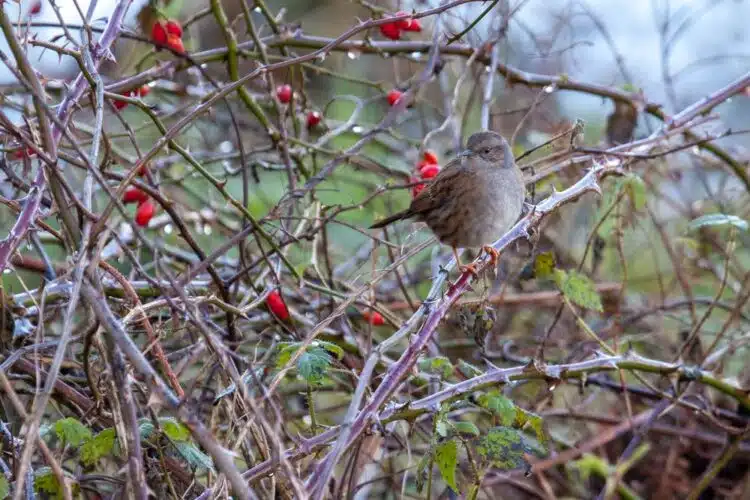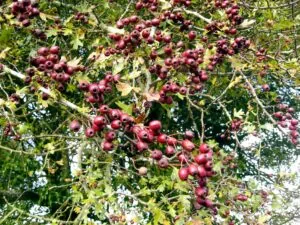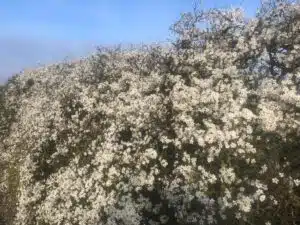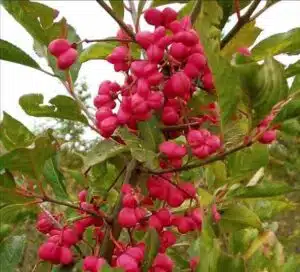HALF PRICE SALE ON EVERYTHING ENDS ON FRIDAY
NEW SEASON BARE ROOTS AT 50% OFF LAST SEASONS PRICES – ENDS 31 JULY
***TODAY ONLY – GET AN EXTRA 10% OFF SALE PRICES WITH CODE FLASH10***
Menu
HALF PRICE SALE ON EVERYTHING ENDS ON FRIDAY
NEW SEASON BARE ROOTS AT 50% OFF LAST SEASONS PRICES – ENDS 31 JULY
***TODAY ONLY – GET AN EXTRA 10% OFF SALE PRICES WITH CODE FLASH10***
 https://www.hopesgrovenurseries.co.uk/wp-content/uploads/2024/02/shutterstock_1461197354-750x500.jpg
https://www.hopesgrovenurseries.co.uk/wp-content/uploads/2024/02/shutterstock_1461197354-750x500.jpg
Gardeners are nurturers by nature: it goes with the job description! We care for plants and, hopefully, they grow for us. We’re also in tune with nature, simply because we’re outside an awful lot. When we’re looking at our plants, we notice the spiders, the bees and the butterflies. They are the living layer: the visual cherry on the gardener’s cake. We hear the birdsong toot and we notice the robin hopping about as we weed. Sometimes, we get a real fright when a frog almost hops into our wellington boots. Yikes!
The trouble is, wildlife is diminishing before our very eyes. I’ve been in my present garden for 18 years and I’ve witnessed a steady decline. I’ve lost the spotted flycatchers from the top of the holly tree. For instance. They would arrive in June and raise a brood. Then the whole family would perch on an upright branch of the holly and they’d dart into the air every few minutes. It was like watching avian gymnastics on the high wire. They disappeared about two years ago, although I still wait for their return. The mistle thrushes, who nested in that self-same holly, have been gone for ten years now. I miss their call and the way they strutted across the field. They adore mistletoe berries, hence their name, although we aren’t warm enough to get mistletoe here. Both of these birds are now on the RSPB’s Red List.
There are fewer bees and butterflies in my garden too, despite it being completely organic. There are no toads on the compost heaps, either. It wasn’t always so. I am old enough to remember how abundant wildlife used to be in the late 1960s and early 1970s. I learnt to drive in 1967, which makes me feel very ancient! My instructor, a retired army Colonel, gave me a real telling off for watching the birds hop along the hedgerow – rather than looking at the road. He widened my vocabulary of the vernacular greatly, using words I’d never heard before.
The verbal battering wouldn’t happen today though, because there aren’t enough birds around to distract learner drivers anymore. Sadly, my four teenage grandchildren will never experience the rich abundance that I took for granted. The decline’s complex. However, the nitty gritty is this. There are fewer insects and other lowly creatures on offer these days and that matters. It’s the lower orders that underpin our food chains. They are at the centre of the food web. Aphids sustain a whole range of creatures, as do slugs and snails and their removal, has a knock-on effect. If you want a song thrush, you need garden snails. You have to have aphids to attract ladybirds and so on.
Native plants attract more insect life, because they’ve evolved side by side for millennia. The mighty English oak, Quercus robur for instance, tops the list. It could sustain over 400 different species of insect. It’s our most wildlife-friendly native of all. Most gardens aren’t large enough to accommodate a mighty oak. However, the quickthorn or hawthorn, Crataegus monogyna, is perfect for gardens large and small. It comes fourth in the league table, after our native oak, willow and birch.

Planting a hawthorn, or a mixed native hedge, will help wildlife to thrive in your garden and beyond. The number of species hawthorn could sustain in theory, is roughly 300 and that includes 149 species of insect. The Woodland Trust tell us that the foliage is the foodplant for caterpillars of many moths, including the hawthorn, orchard ermine, pear leaf blister, rhomboid tortrix, light emerald, lackey, vapourer, fruitlet-mining tortrix, small eggar and lappet moths.
The flowers, which are eaten by dormice, provide nectar and pollen for bees and other pollinating insects. Walking along a hedge in May allows you to drink in the ‘cakey’ fragrance, or is it sweet wine? Once pollination is complete, red haws appear and there are lots of them. They look like small rose hips with good reason: the hawthorn is a member of the rose family. The winter-red hips look wonderful in autumn light.
The dense, thorny structure offers shelter and nesting sites for many species of bird and that’s important because nesting sites are in short supply. Farmers tend to scalp the hedges and remove the fruit before the birds get a chance to devour the haws. Allow your hawthorn hedge to billow, if you can. Trimming hawthorn hedges needs to wait until late winter, ideally. By then many migrating birds, including thrushes, redwings and fieldfares, will have devoured the fruit which is rich in antioxidants. Small mammals also feast on the haws.
You could plant a mixed hedgerow and add even more colour and blackthorn, or sloe, is the perfect partner because the round fruits are blue-black. The Latin name, Prunus spinosa, meaning ‘spiny cherry’, gives a clue to the long thorns. Place this carefully, away fromn gates and people. The white blossom appears early and is prompted by cool temperatures. The blossom lasts until warmer weather arrives, so country people,like me, refer the Blackthorn Winter. April quite often often brings easterly winds and the icy white blackthorn flowers send an extra shiver down your back.
The naturalist Gilbert White (1720 – 1793) had plenty to say on the subject. On April 7th 1773 he wrote this ‘tree usually blossoms while cold N.E. winds blow … this season is called by the country people black-thorn winter.’ Early flying native bumblebees benefit greatly from blackthorn blossom, because they are able to fly earlier than most pollinators due to being able to warm their bodies up chemically. They will fly in cool but clement weather, when temperatures are hovering close to 10C, or 50F. Five species of bumblebee actually live inside the Arctic Circle. Their furry bodies help.
Early flowers are vital for wildlife, because solitary bees and native bumblebee queens hibernate without any food. The first queen to appear is normally Bombus terrestris, the Buff-tailed bumblebee. These large queens, over an inch in length in old money, are often about on fine, winter afternoons. The queens have buff-tails and two yellow bands, one at the front of the thorax and one in the middle of the abdomen. They need an immediate supply of nectar to energise them. After that, they look for a nesting site on a sunny dry bank. Then they begin to look for pollen, the protein-rich substance needed to produce a brood. If they fail to find nectar, they perish.

Blackthorn blossom is almost certainly pollinated by early-flying bumblebee queens, because most pollinators don’t venture out in cool temperatures. Other good winter-flowering, bumblebee nectar plants include Mahonia x media ‘Charity and Clematis cirrhosa var. balearica. Crocuses are also excellent. Give all early-flowering plants a warm, bright spot, so that the nectar supply flows. These earlier flowering bumblebees are all short-tongued and appreciate simply shaped flowers.
Blackthorn foliage is a food plant for the caterpillars of many moths, including the lackey, magpie, swallow-tailed and yellow-tailed. It is also used by the black and brown hairstreak butterflies. They lay their eggs on the twiggy stems. Birds will nest among the dense, thorny thickets. The ink-black fruits, which are visible by late-summer, are avidly collected and used to flavour gin, although your hands bear the scars afterwards. If you don’t pick the sloes by September, the birds soon strip the bushes.
The most nutritious fruit of all belongs to the spindleberry, or Euonymus europaeus. This bears vivid fruits and each one forms a bright-pink carousel with dangling orange seeds that seem to lean outwards like fairground swings in full pelt. These long-lived trees can live for a hundred years or more and the foliage turns vivid red in early autumn, so they make good additions specimens as well as hedging plants.

The straight twigs were used as spindles for spinning, holding wool, skewers, toothpicks, pegs and knitting needles. The fruits were baked and powdered and used to treat head lice, or mange in cattle. It’s a case of don’t try this at home though, for the purgative leaves and fruit are toxic to humans. They’ve have also been known to kill sheep. Robins adore spindle berries and they will fight to keep other birds away from their prized bush. Male robins are very aggressive and it’s said that 10 per cent of older robins die defending their territory.
You don’t have to wait until spring to hear their high-pitched song either. Robins are very territorial and they sing throughout winter as well, although and they show themselves off as they sing, rather like Teddy boys at dances. Spruced up and looking for trouble.
You’ll find a range of native hedging plants, some floral, some fruitful and some bird-friendly. These are sold as bare root plants, between November and April. They are dormant, but they romp away in the following spring. You’ll be helping wildlife to thrive as well.
Many of our customers buy topiary plants (and hedging plants) to grow in containers, one frequently asked question is how large does the pot that I plant them into need to be?
Expert horticultural advice on the merits and pitfalls of planting bare root yews, and how to get the best from them.
Pleached trees are a garden-design favourite, because they provide an instant leafy screen that looks stylish as soon as it’s planted. They offer privacy for you and they help to muffle noise and that’s becoming more important in our busy world. They provide a living screen that’s far more eco-friendly than a stark wooden fence…